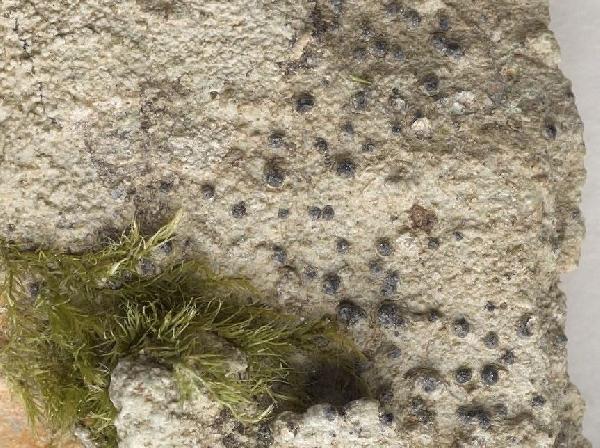Swinscowia porinoides (Canals, Boqueras & Gómez-Bolea) S.H. Jiang, Lücking & Sérus.
in Hongsanan & al., Fungal Divers.: 10.1007/s13225-020-00462-6, 140, 2020. Basionym: Strigula porinoides Canals, Boqueras & Gómez-Bolea - Mycotaxon, 55: 391, 1995.
Synonyms:
Distribution: S - Si (Nimis & al. 1994, Canals & al. 1995, Roux & Sérusiaux 2004).
Description: Thallus crustose, hemiendosubstratic, continuous or rimose, pale grey, pinkish white or pale green, 0.2-0.25 mm thick. Perithecia black, hemispherical, 0.5-0.8 mm across, half-immersed. Involucrellum black, thick, covering the upper two thirds of the perithecium; exciple colourless; hamathecium of thread-like, persistent, mostly simple paraphysoids. Asci 8-spored, clavate, bitunicate-fissitunicate, shortly stalked at base, the apex thickened into a tholus, with a narrow ocular chamber, I-. Ascospores submuriform to muriform, with 7-10 transverse septa and (0-)1-4(-5) longitudinal septa, hyaline, fusiform or subfusiform, (20-)23-31(32.5 x (5-)6-8.5(-9.5) µm. Macropycnidia black, 0.3-0.4 mm across, globulose, half-immersed, with a dimidiate involucrellum; macroconidia (13.5)19-25(-26.5) x (4-)5-6.5(-85) µm, cylindrical to subfusiform, with (3-)4-7 transverse septa and 0-2 longitudinal septa, with rounded apices provided with a mucous appendage measuring 3-8.6 x 1.5-4 µm. Micropycnidia similar but 0.08-0.15 mm across; microconidia short-cylindrical, 2-3(4.5) x 1-2 µm. Photobiont trentepohlioid. Spot tests: thallus K-, C-, KC-, P-. Chemistry: thallus without lichen substances.
Note: on calcareous rocks, rarely also on smooth bark, mostly in Mediterranean forests; the species is hitherto known only from the island of Marettimo, from Catalonia in Spain, and from the Carnic Alps in Austria (Breuss 2012).
Growth form: Crustose
Substrata: rocks
Photobiont: Trentepohlia
Reproductive strategy: mainly sexual, or asexual by conidia and thalloconidia
Commonnes-rarity: (info)
Alpine belt: absent
Subalpine belt: absent
Oromediterranean belt: absent
Montane belt: absent
Submediterranean belt: absent
Padanian area: absent
Humid submediterranean belt: absent
Humid mediterranean belt: very rare
Dry mediterranean belt: absent

Predictive model
Growth form: Crustose
Substrata: rocks
Photobiont: Trentepohlia
Reproductive strategy: mainly sexual, or asexual by conidia and thalloconidia
Commonnes-rarity: (info)
Alpine belt: absent
Subalpine belt: absent
Oromediterranean belt: absent
Montane belt: absent
Submediterranean belt: absent
Padanian area: absent
Humid submediterranean belt: absent
Humid mediterranean belt: very rare
Dry mediterranean belt: absent

Predictive model
 INDEX FUNGORUM
INDEX FUNGORUM
 GBIF
GBIF


